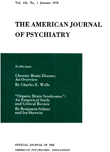Phenothiazines and Diabetes in Hospitalized Women
Abstract
Between 1955 and 1966 the prevalence of diabetes among hospitalized psychotic women patients rose from 4.2 to 17.2 percent. The increase followed the introduction of chlorpromazine therapy in 1954. About every fourth patient who had been treated for one year or longer with more than 100 mg. daily of chlorpromazine or corresponding doses of another psychoactive pheno thiazine developed hyperglycemia and glycosuria. The disturbance resembled adult-onset diabetes, but there were fewer complications.
In 25 percent of the patients remissions occurred either after withdrawal of the drug or reduction in dosage. Obese patients over 50 years old and those with a family history of diabetes were more often affected. Patients with paranoid schizophrenic reaction developed diabetes after phenothiazine therapy relatively more frequently than did those with other forms of schizophrenic reactions or with nonschizophrenic psychiatric diagnoses.
Access content
To read the fulltext, please use one of the options below to sign in or purchase access.- Personal login
- Institutional Login
- Sign in via OpenAthens
- Register for access
-
Please login/register if you wish to pair your device and check access availability.
Not a subscriber?
PsychiatryOnline subscription options offer access to the DSM-5 library, books, journals, CME, and patient resources. This all-in-one virtual library provides psychiatrists and mental health professionals with key resources for diagnosis, treatment, research, and professional development.
Need more help? PsychiatryOnline Customer Service may be reached by emailing [email protected] or by calling 800-368-5777 (in the U.S.) or 703-907-7322 (outside the U.S.).



